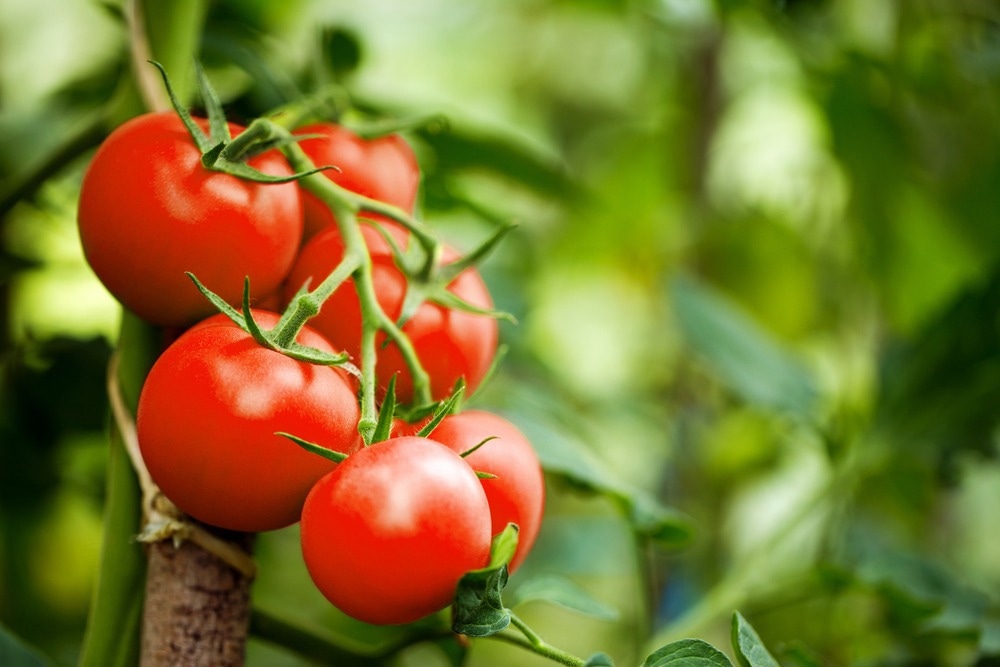A recent study published in the journal ACS Agricultural Science & Technology investigates the hybridization of chitosan and silver nanoparticles for boosting the antibacterial properties in tomato plants.

Study: Hybridization of Chitosan and Biosynthesized Silver Nanoparticles to Enhance Antimicrobial Activity against Phytopathogens in Tomato (Solanum lycopersicum). Image Credit: eugenegurkov/Shutterstock.com
The produced chitosan-hybridized biogenic silver nanoparticles (Ch@BSNPs) have remarkable biocompatibility, suggesting that these materials can be used as safe and efficient antibacterial bioagents for green nano-enabled farming.
Nanotechnology for Agricultural Applications
Nanotechnology has evolved as a highly efficient and remarkably successful technique for supplementing or even replacing many traditional agriculture practices.
Metal and metal oxide nanomaterials have been extensively researched for infection control in a variety of disease systems. Many studies show that they are highly efficient in agricultural applications because of their bioactivity and bioavailability.
However, several of these compounds have uncharacteristic environmental consequences, raising concerns about the biological hazards of such materials if extensively used in food production.
There has been a major interest in the creation of biological methods for the green production of metallic nanoparticles in recent times.
Many experts argue that these nanomaterials are more efficient for agricultural purposes, both in terms of manufacturing and usage. Several papers have been published recently on the use of organic substrates for producing metallic nanoparticles that offer cost-effective, biodegradable, non-toxic, and ecologically friendly nanomaterials.
Biogenic Silver Nanoparticles (BSNPs); Why are they Important?
Biogenic silver nanoparticles have lately sparked considerable attention owing to their exceptional antibacterial activity and relatively little cellular toxicity. These biogenic silver nanoparticles can be manufactured utilizing environmentally friendly green chemistry methods.
Various biologically or chemically generated materials and ligands are utilized to tune the form, size, interface potential, and general reactivity of silver nanoparticles. The production of silver nanoparticles from biodegradable materials can greatly improve their biocompatibility and antibacterial activity.
Understanding the significance of critical biological moieties linked with silver nanoparticles will allow for optimization of production methods, resulting in the most cost-effective and environmentally sustainable crop protection solutions.
Chitosan-Hybridized BSNPs for Growth of Tomato Plants
Biogenic silver nanoparticles and chitosan nanomaterials have previously been shown to exhibit unique antibacterial activities against specific tomato plant pathogens. However, the effectiveness and cumulative potential of bioactive silver nanoparticles and chitosan composite materials are still unclear.
The tomato plant Solanum Lycopersicum is the second most important vegetable product after potatoes, and it is severely affected by a wide variety of infections. To reduce crop damage, various chemical pesticides such as copper-based insecticides, carbendazim, bonide mancozeb, and chlorothalonil are used.
However, the widespread use of pesticides creates a severe environmental concern. Biologically produced nanoscale materials generated from microbe and plant extracts are highly biocompatible and may be utilized to sustainably improve antibacterial capabilities in tomato plants.
Highlights of the Current Study
In this study, the researchers concentrated on creating polymer-fabricated bioactive silver nanoparticles utilizing T. Viride's extracellular compounds and further chitosan hybridization.
The antibacterial efficacy was tested in vitro against a variety of plant pathogens. Greenhouse research with the tomato plant was also used to assess disease control abilities via systematic investigation of biological and behavioral characteristics.
Transmission electron microscopy (TEM), X-Ray diffraction (XRD), energy dispersive X-ray analysis (EDX), and scanning electron microscopy (SEM) was used to analyze chitosan hybridization and T. Viride-derived chemicals coupled with silver nanoparticles.
Key Developments and Future Outlook
Chitosan-hybridized biogenic silver nanoparticles (Ch@BSNP) were found to limit the development of both fungal strains and bacterial pathogens.
Furthermore, Ch@BSNP substantially decreased disease frequency in greenhouse-grown tomato plants, leading to biotic stress relief from numerous pathogens, as seen by the growth and therapeutic properties of the tomato plant. These advantages of the Ch@BSNP can be linked to biological compounds extracted from T. Viride.
Using biogenic silver nanoparticles in combination with chitosan resulted in a novel and long-lasting antibacterial agent against a wide spectrum of pathogens in the tomato plant.
These results suggest that biosynthesized nanoparticles constitute an important new area of research in the establishment of green crop protection techniques based on nanotechnology. The green silver nanoparticles created in this work offer tremendous promise as a unique and green crop protection solution, with the ability to significantly improve agricultural productivity and food safety.
Reference
Giri, V. P. et al. (2022). Hybridization of Chitosan and Biosynthesized Silver Nanoparticles to Enhance Antimicrobial Activity against Phytopathogens in Tomato (Solanum Lycopersicum). ACS Agricultural Science & Technology. Available at: https://doi.org/10.1021/acsagscitech.1c00252
Disclaimer: The views expressed here are those of the author expressed in their private capacity and do not necessarily represent the views of AZoM.com Limited T/A AZoNetwork the owner and operator of this website. This disclaimer forms part of the Terms and conditions of use of this website.